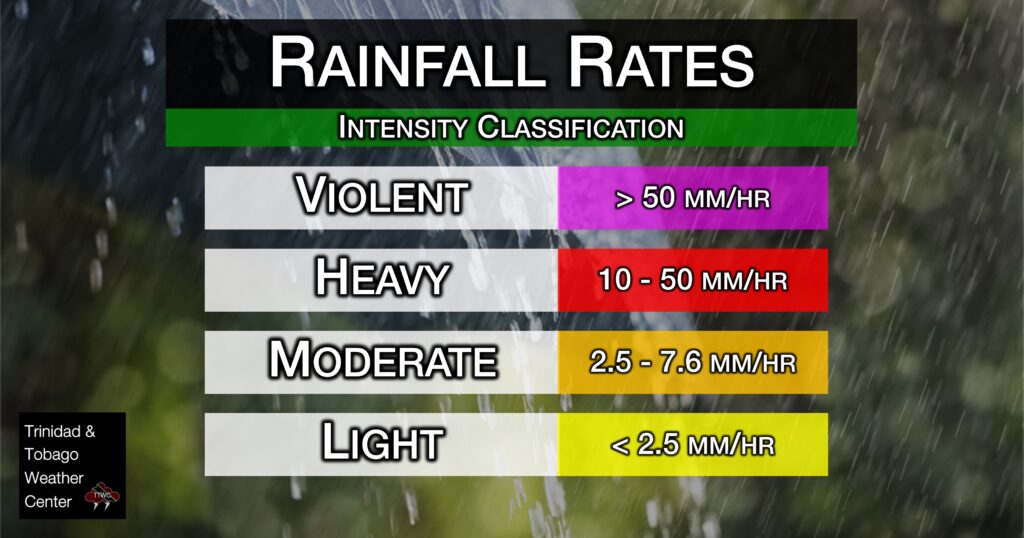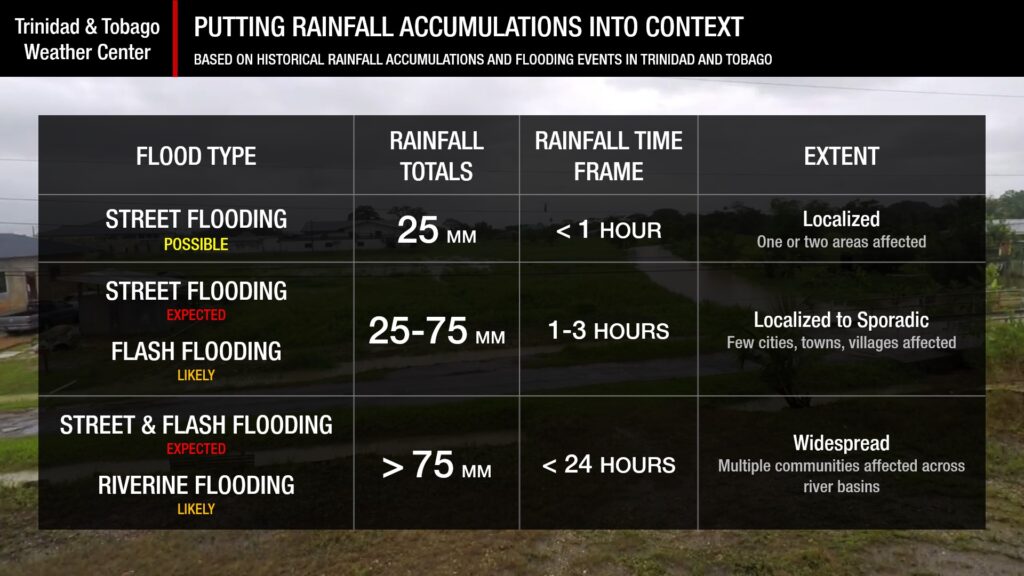Over the next three days, through Tuesday, periods of rain, showers, and thunderstorms are forecast to affect Trinidad and Tobago. This is mainly due to the Intertropical Convergence Zone (ITCZ) interacting with a trough (moved across the Windwards on Saturday night) and a Tropical Wave, set to move across the region on Sunday night through Monday.
What you need to know
— Rainfall: Over the next five days, through Thursday, overall rainfall accumulations across the country are forecast to range between 25 and 75 millimeters, with five-day totals up to 125 millimeters possible. In highly isolated areas, daily rainfall totals exceeding 50 millimeters are likely, mainly Sunday through Tuesday.
— Saharan Dust: Throughout the forecast period, mild to moderate Saharan Dust concentrations are likely, particularly across Tobago and from Tuesday morning.
— Hazards: Daily, but particularly Sunday through Tuesday morning, locally heavy rainfall is likely in heavy showers/thunderstorms, producing localized street/flash flooding. Gusty winds up to 50 KM/H, as well as frequent cloud-to-ground lightning, are also possible, with stronger wind gusts likely north of Trinidad and Tobago.
— Marine: Generally moderate seas are forecast through Monday, with slight to moderate seas thereafter.
Latest Alerts
TTMS Issues Adverse Weather Alert For T&T
Trinidad and Tobago is NOT under any tropical storm or hurricane threat, watch, or warning at this time.
The Forecast
Sunday
SundayMonday
MondayTuesday
TuesdayWednesday
WednesdayThursday
ThursdayMarine Forecast
Slight to Moderate Seas Forecast For T&T
Temperatures
Sunday
Low: 25-27°C
High: 31-33°C
Monday
Low: 23-25°C
High: 28-30°C
Tuesday
Low: 24-26°C
High: 30-32°C
Wednesday
Low: 25-27°C
High: 32-34°C
Thursday
Low: 25-27°C
High: 32-34°C
Forecast Impacts
Flooding
Over the next five days, through Thursday, overall rainfall accumulations across the country are forecast to range between 25 and 75 millimeters, with five-day totals up to 125 millimeters possible. In highly isolated areas, daily rainfall totals exceeding 50 millimeters are likely, mainly Sunday through Tuesday.
Street & Flash Flooding
Street & Flash FloodingRiverine Flooding
Riverine FloodingForecast Rainfall Totals
- Sunday: Between 5 and 15 millimeters across the country, with localized totals up to 25 millimeters in heavy showers or thunderstorms.
- Monday: Between 10 and 25 millimeters of rainfall across both islands, with isolated totals between 25 and 50 millimeters, particularly in heavy thunderstorm/shower activity.
- Tuesday: Between 10 and 25 millimeters of rainfall across both islands, with isolated totals between 25 and 50 millimeters, favoring western coastal areas. Note that this precipitation forecast is less certain. See forecast discussion for details.
- Wednesday: Less than 5 millimeters of rainfall across the country, with isolated higher totals of up to 25 millimeters favoring western coastal areas.
- Thursday: Less than 5 millimeters of rainfall across the country, with isolated higher totals of up to 25 millimeters favoring western coastal and northern areas of Trinidad.

Understanding Rainfall Accumulations
Putting the rainfall forecast into context, rainfall rates in excess of 50 millimeters per hour or areas that receive in excess of 25 millimeters within an hour tend to trigger street flooding across the country or flash flooding in northern Trinidad. For riverine flooding to occur, a large area of the country (not just in highly localized areas of western coastal Trinidad) would have to record upwards of 75 millimeters within 24 hours, and rainfall would have to fall across major rivers’ catchment areas.

Strong Thunderstorms
Strong ThunderstormsWhat is a strong or severe thunderstorm?
Given how rare these types of thunderstorms are in our region – we classify a severe or strong thunderstorm as one that produces any of the following:
- Damaging wind gusts exceeding 55 KM/H;
- Frequent lightning (more than 30 cloud-to-ground strikes within a 10-minute period);
- Hail (of any size);
- Rainfall of more than 50 millimeters or more within an hour or exceeding 75 millimeters or more within three hours;
- The sighting of a funnel cloud or touchdown of a waterspout/tornado associated with the thunderstorm.
Gusty Winds
Gusty WindsWith winds gusting above 50 KM/H, whole trees can be in motion, with larger trees and weaker branches falling. Light outdoor objects can topple or become airborne, such as garbage cans, loose galvanize, construction material, and outdoor furniture. Tents may also jump.
Other Hazards
Saharan Dust Forecast
Dust-Free Days Ahead For T&T As Saharan Dust Stays North
Why I May Not/Will Not See Rainfall?
A frequent complaint is the forecast is wrong because I didn’t experience any rainfall. Scattered showers mean that you, individually, may experience some showers intermittently throughout the day, and there is a higher chance for this activity than isolated activity. Widespread showers mean that nearly all persons and areas may experience rainfall.
On Sunday through Tuesday, isolated to scattered rainfall is likely, with isolated rainfall possible on Wednesday and Thursday.

Forecast Discussion
On Saturday night into Sunday morning. a weak low-level trough moved across T&T, the Windward and Leeward Islands, interacting with the Intertropical Convergence Zone (ITCZ). This brought a couple showers and isolated thunderstorms across T&T on Saturday afternoon through early Sunday morning.
On Sunday, with a fairly moist atmosphere, marginally favorable low-level convergence, upper-level divergence, and ample instability, showers, and thunderstorms are likely, particularly during the late morning through afternoon across Trinidad. Forecast models also show a marginally severe set-up, meaning isolated thunderstorms could become locally strong – producing heavy to violent rainfall, frequent lightning, and gusty winds.
However, a tropical wave, Tropical Wave 27, is set to interact with the ITCZ on Sunday night through Monday. While forecast models show overall heavier rainfall and stronger winds between 25 and 35 knots (45 KM/H – 65 KM/H) remain north of T&T, the atmosphere is forecast to become primed for locally heavy rainfall on Monday through the first half of Tuesday.
Based on the latest forecast guidance, models show the atmosphere becoming nearly saturated as Monday progresses, with relative humidity through the atmosphere above 80%, precipitable water values above 2 inches, CAPE (a measure of instability) between 1250 and 2250 J/kg, favorable low-, mid-, and upper-level conditions with moderate wind shear from the northeast.
The timing of when dry and stable conditions return to T&T among the top models still differs. The EMCWF shows less rainfall and a drier atmosphere from Tuesday morning, while the GFS keeps a much more moist and unstable atmosphere across T&T through Tuesday afternoon. This difference in timing has some consequences for overall rainfall amounts on Tuesday, but at this point in time, the GFS appears to be better suited to capture anticipated conditions on Tuesday. It should be noted that this can change, leading to drier conditions than forecast.
Based on the latest guidance, conditions are set to become increasingly dry by midday on Tuesday as a high-pressure ridge rebuilds across T&T. However, the country will remain on the periphery of said ridge. As a result, winds are forecast to remain generally light, with moisture being advected from the southeast across T&T.
On Wednesday and Thursday, early morning showers due to pre-dawn convergence, then isolated afternoon showers and the odd thunderstorm will be possible due to daytime heating and sea breeze convergence. This will result in rainfall favoring western coastal Trinidad and hilly areas of the country.
Dust models also show a moderate to high concentration surge of Saharan Dust moving in Thursday morning, leading to increasingly hazy/dusty conditions into next weekend.












